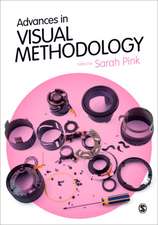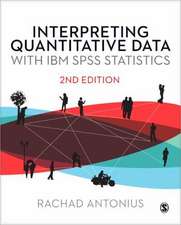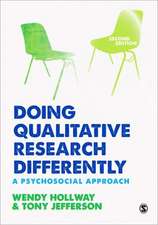Polytomous Item Response Theory Models: Quantitative Applications in the Social Sciences, cartea 144
Autor Remo Ostini, Michael L. Neringen Limba Engleză Paperback – 28 sep 2005
Din seria Quantitative Applications in the Social Sciences
-
 Preț: 306.08 lei
Preț: 306.08 lei -
 Preț: 270.02 lei
Preț: 270.02 lei -
 Preț: 270.25 lei
Preț: 270.25 lei -
 Preț: 274.06 lei
Preț: 274.06 lei -
 Preț: 270.29 lei
Preț: 270.29 lei -
 Preț: 304.51 lei
Preț: 304.51 lei -
 Preț: 304.83 lei
Preț: 304.83 lei -
 Preț: 313.80 lei
Preț: 313.80 lei -
 Preț: 305.60 lei
Preț: 305.60 lei -
 Preț: 304.77 lei
Preț: 304.77 lei -
 Preț: 306.14 lei
Preț: 306.14 lei -
 Preț: 273.46 lei
Preț: 273.46 lei -
 Preț: 275.42 lei
Preț: 275.42 lei -
 Preț: 277.33 lei
Preț: 277.33 lei -
 Preț: 305.05 lei
Preț: 305.05 lei -
 Preț: 271.10 lei
Preț: 271.10 lei -
 Preț: 270.63 lei
Preț: 270.63 lei -
 Preț: 305.05 lei
Preț: 305.05 lei -
 Preț: 304.51 lei
Preț: 304.51 lei -
 Preț: 305.28 lei
Preț: 305.28 lei -
 Preț: 270.40 lei
Preț: 270.40 lei -
 Preț: 305.60 lei
Preț: 305.60 lei -
 Preț: 304.77 lei
Preț: 304.77 lei -
 Preț: 306.14 lei
Preț: 306.14 lei -
 Preț: 306.34 lei
Preț: 306.34 lei -
 Preț: 305.40 lei
Preț: 305.40 lei -
 Preț: 306.41 lei
Preț: 306.41 lei -
 Preț: 304.77 lei
Preț: 304.77 lei -
 Preț: 305.60 lei
Preț: 305.60 lei -
 Preț: 304.51 lei
Preț: 304.51 lei -
 Preț: 269.91 lei
Preț: 269.91 lei -
 Preț: 270.40 lei
Preț: 270.40 lei -
 Preț: 269.91 lei
Preț: 269.91 lei -
 Preț: 289.18 lei
Preț: 289.18 lei -
 Preț: 287.82 lei
Preț: 287.82 lei -
 Preț: 316.12 lei
Preț: 316.12 lei -
 Preț: 288.96 lei
Preț: 288.96 lei -
 Preț: 316.71 lei
Preț: 316.71 lei -
 Preț: 314.98 lei
Preț: 314.98 lei -
 Preț: 317.26 lei
Preț: 317.26 lei -
 Preț: 314.60 lei
Preț: 314.60 lei -
 Preț: 289.95 lei
Preț: 289.95 lei -
 Preț: 289.18 lei
Preț: 289.18 lei -
 Preț: 315.36 lei
Preț: 315.36 lei -
 Preț: 314.98 lei
Preț: 314.98 lei -
 Preț: 314.38 lei
Preț: 314.38 lei -
 Preț: 316.33 lei
Preț: 316.33 lei -
 Preț: 316.51 lei
Preț: 316.51 lei
Preț: 289.95 lei
Nou
Puncte Express: 435
Preț estimativ în valută:
55.48€ • 58.08$ • 45.91£
55.48€ • 58.08$ • 45.91£
Carte tipărită la comandă
Livrare economică 07-21 aprilie
Preluare comenzi: 021 569.72.76
Specificații
ISBN-13: 9780761930686
ISBN-10: 076193068X
Pagini: 120
Dimensiuni: 140 x 216 x 7 mm
Greutate: 0.14 kg
Ediția:New.
Editura: SAGE Publications
Colecția Sage Publications, Inc
Seria Quantitative Applications in the Social Sciences
Locul publicării:Thousand Oaks, United States
ISBN-10: 076193068X
Pagini: 120
Dimensiuni: 140 x 216 x 7 mm
Greutate: 0.14 kg
Ediția:New.
Editura: SAGE Publications
Colecția Sage Publications, Inc
Seria Quantitative Applications in the Social Sciences
Locul publicării:Thousand Oaks, United States
Cuprins
Series Editor's Introduction
Acknowledgments
1. Introduction
Measurement Theory
Item Response Theory
Applying the IRT Model
Reasons for Using Polytomous IRT Models
Polytomous IRT Models
Two Types of Probabilities
Two Types of Polytomous Models
Category Boundaries
Item Category Response Functions
2. Nominal Response Model
The Mathematical Model
Information
Relationship to Other IRT Models
Variations
A Practical Example
3. Polytomous Rasch Models
Partial Credit Model
Category Steps
The Mathematical Model
Information
Relationship to Other IRT Models
Variations
PCM Summary
Rating Scale Model
The Mathematical Model
Model Parameters
Sufficient Statistics and Other Considerations
Information
Expected Values and Response Functions
Response Functions and Information
Relationship to Other IRT Models
PCM Scoring Function Formulation and the NRM
Variations
Generalized Partial Credit Model
Discrimination and Polytomous Rasch Models
Summary of Polytomous Rasch Models
Three Practical Examples
4. Samejima Models
Framework
From Response Process to Specific Model
The Homogeneous Case: Graded Response Models
The Mathematical Model
Information
Information for Polytomous Models
Relationship to Other IRT Models
From Homogeneous Class to Heterogeneous Class and Back
A Common Misconception
Variations
Summary of Samejima Models
Potential Weaknesses of the Cumulative Boundary Approach
Possible Strengths of the Cumulative Boundary Approach
A Practical Example
5. Model Selection
General Criteria
Mathematical Approaches
Fit Statistic Problems
An Example
Differences in Modeled Outcome
Conclusion
Acronyms and Glossary
Notes
References
Index
About the Authors
Acknowledgments
1. Introduction
Measurement Theory
Item Response Theory
Applying the IRT Model
Reasons for Using Polytomous IRT Models
Polytomous IRT Models
Two Types of Probabilities
Two Types of Polytomous Models
Category Boundaries
Item Category Response Functions
2. Nominal Response Model
The Mathematical Model
Information
Relationship to Other IRT Models
Variations
A Practical Example
3. Polytomous Rasch Models
Partial Credit Model
Category Steps
The Mathematical Model
Information
Relationship to Other IRT Models
Variations
PCM Summary
Rating Scale Model
The Mathematical Model
Model Parameters
Sufficient Statistics and Other Considerations
Information
Expected Values and Response Functions
Response Functions and Information
Relationship to Other IRT Models
PCM Scoring Function Formulation and the NRM
Variations
Generalized Partial Credit Model
Discrimination and Polytomous Rasch Models
Summary of Polytomous Rasch Models
Three Practical Examples
4. Samejima Models
Framework
From Response Process to Specific Model
The Homogeneous Case: Graded Response Models
The Mathematical Model
Information
Information for Polytomous Models
Relationship to Other IRT Models
From Homogeneous Class to Heterogeneous Class and Back
A Common Misconception
Variations
Summary of Samejima Models
Potential Weaknesses of the Cumulative Boundary Approach
Possible Strengths of the Cumulative Boundary Approach
A Practical Example
5. Model Selection
General Criteria
Mathematical Approaches
Fit Statistic Problems
An Example
Differences in Modeled Outcome
Conclusion
Acronyms and Glossary
Notes
References
Index
About the Authors
Notă biografică
After specializing in psychometric methods and bioethics at the University of Minnesota, Remo taught 3020 and 4050 in the School of Psychology at UQ for a number of years. A stint in the School of Pharmacy at UQ, doing systematic reviews of medicine prescribing and some pharmacoepidemiology, followed. Now Remo has gone back to his roots, measuring health behaviors and community well being in the Healthy Communities Research Center at UQ. Remös research focuses on health literacy, including the effect of health literacy on health behaviors as well as predictors and components of health literacy. Of particular interest are the issues of health literacy motivation and responsibility. Remo maintains an honorary appointment in the School of Psychology and continues to supervise students in the school.
Descriere
Polytomous Item Response Theory Models provides a unified, comprehensive introduction to the range of polytomous models available within item response theory (IRT). It begins by outlining the primary structural distinction between the two major types of polytomous IRT models. This focuses on the two types of response probability that are unique to polytomous models and their associated response functions, which are modeled differently by the different types of IRT model. It describes, both conceptually and mathematically, the major specific polytomous models, including the Nominal Response Model, the Partial Credit Model, the Rating Scale model, and the Graded Response Model.














